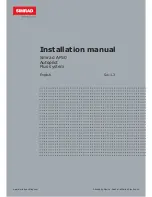Rubicon
2
Manual
Wave Type Switches
A. SINE TYPE switch
- Sets the shape of the waveform appearing at the SINE OUT jack. If
set to the left, the output is a pure SINE wave. If set to the middle, the output is a
SIGMOID. If set to the right, the output is a DOUBLE SIGMOID, which has the effect of
doubling the base frequency at the SINE OUT jack.
TECH NOTE:
The output of Rubicon
2
’s sine shaper circuit is what actually appears at the
SINE OUT jack. With this switch in the left position, Rubicon
2
feeds a triangle wave into
that circuit, resulting in a sine wave. With the switch in either the middle or right
positions, Rubicon
2
feeds a sawtooth wave into that circuit, resulting in a sigmoid wave.
Sigmoids sound similar to sawtooth waves, only “warmer,” and are great for creating
metallic sounds.
B. PULSE TYPE switch
- This switch sets whether Rubicon
2
pulse waves are
edge-triggered or center-triggered. Specifically, with the switch in the left position, the
PULSE and TRI STATE PULSE waves are center-triggered. With the switch in the
middle position, these pulse waves are edge-triggered. With the switch to the right, the
pulse waves are edge-triggered, but at double the frequency. Note that PULSE TYPE
does not affect the SUB oscillator (which is always a square wave), but it does affect the
WARP waveform, since the TRI STATE PULSE is a component of the WARP circuit.
Center-triggering results when you send a triangle wave to the pulse comparator, and
edge-triggered pulses result from sending a sawtooth wave to the pulse comparator. The
two waveforms are essentially the same, but have different phase relationships, so they
sound different when blended or synchronized with other waveforms. In general, edge
Page 8


















